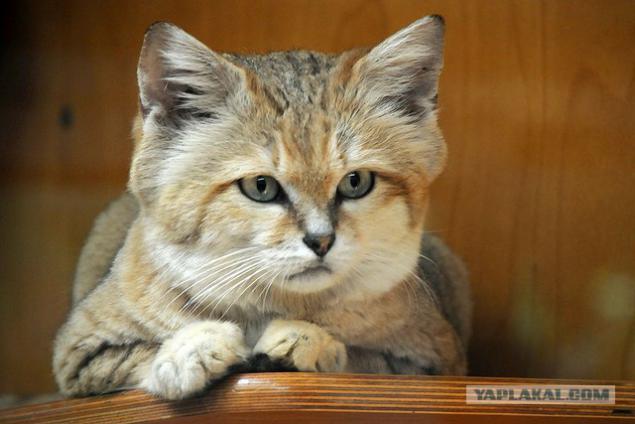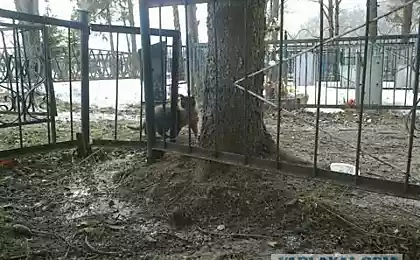1069
Desert Cat
There will be 9 pictures and text.
Source part: proxvost.info

The desert cat or cat Barchan (lat.Felis margarita)
Barchan cat, sand cat, sand cat, desert cat (Felis margarita), South Morocco, North Africa, Arabia, Iran and Central Asia - that public lands settled Barchan (desert) cat everywhere she chose to live alone desert. And that's okay! By their harsh conditions it is well adapted.

Zoologists have discovered desert cat twice. First introduced in 1858, with its North African species. Then, in 1926, the Moscow scholar S.I.Ognev described Barkhans cat inhabiting the Karakum and Kyzylkum. Color it somewhat different from the African. Due to the fact that in the winter in Central Asia is cold enough, at Barchan cats at this time there is a long and thick winter coat. Her color gray, is markedly different from the summer yellowish.

In general, desert cat is very noticeable on the outside of her background: her sandy-yellow with gray patina. Gray-brown stripes poorly visible, sometimes they are so merged with the general color of the coat, the animal seems to be monotonous. But on the head and legs of the animal pattern often emerges. The tip of the tail blackish or black. The underside of the body is usually lighter than the top. Length desert cat ranges from 0, 65 to 0, 90 m, and 40% took the tail.

The head is broad and short, flattened, with whiskers. Ears very large and broad. It is not surprising, because the production has to track down the ear. Tassels on the ears there. Vision is also very good. Iris yellow slit-shaped pupil. Paws at the desert cats are quite large and heavy. Long hair tightly envelops the foot pads, which have other cats usually bare. When walking, it saves from burns, as the sand of the day heats up very strongly. Thus, in the apt remark H.Blonka this animal goes "in the thick wool of his own sandals».

Desert cat hunts birds, gerbils and other small mammals, as well as the locusts, and non-poisonous snakes. There her enemies - the large birds of prey, poisonous snakes and wolves.
Large prey often bury themselves in the sand to get back to it later to feed. In addition, it preys on snakes gerbils, gerbils, hares, insects.
Sand cat may for a long time without water, and most of the moisture from the food gets.
Most of the year Barkhans cat wanders through his site in search of prey. During the night it may take 8-10 km. Move quickly rushes, low above the ground lowered body, like the stele. At a short distance can reach speeds up to 40 km / h

The hottest months passes only nocturnal. In winter and early spring sand cat can be seen during the day. Heat of the day waits in a hole. For this purpose, use the abandoned burrows of Korsakov, porcupines, gerbils and ground squirrels, pre-expanding them. Sometimes sand cat digs shallow burrows own holes or under bushes of saxaul.

Before you get out of the hole, she spent 15 minutes carefully examining the surroundings. Similarly, the cat acts and on his return to the burrow. Hearing desert cat is well developed. It helps to hear it approaching as mining and enemies.
In nature, reproduction takes place from January to April. The female brings 4-5 blind kittens. Their eyes open at 12-16 days. In three weeks, the kittens begin to emerge from the burrow.

In the last month - leaving a hole and begin to eat solid food. Up to 4 months, kittens remain with their mother, and then become completely independent.
Because of the latent lifestyle population size is unknown. It is now known 4 subspecies desert cat.

Source:
Source part: proxvost.info

The desert cat or cat Barchan (lat.Felis margarita)
Barchan cat, sand cat, sand cat, desert cat (Felis margarita), South Morocco, North Africa, Arabia, Iran and Central Asia - that public lands settled Barchan (desert) cat everywhere she chose to live alone desert. And that's okay! By their harsh conditions it is well adapted.

Zoologists have discovered desert cat twice. First introduced in 1858, with its North African species. Then, in 1926, the Moscow scholar S.I.Ognev described Barkhans cat inhabiting the Karakum and Kyzylkum. Color it somewhat different from the African. Due to the fact that in the winter in Central Asia is cold enough, at Barchan cats at this time there is a long and thick winter coat. Her color gray, is markedly different from the summer yellowish.

In general, desert cat is very noticeable on the outside of her background: her sandy-yellow with gray patina. Gray-brown stripes poorly visible, sometimes they are so merged with the general color of the coat, the animal seems to be monotonous. But on the head and legs of the animal pattern often emerges. The tip of the tail blackish or black. The underside of the body is usually lighter than the top. Length desert cat ranges from 0, 65 to 0, 90 m, and 40% took the tail.

The head is broad and short, flattened, with whiskers. Ears very large and broad. It is not surprising, because the production has to track down the ear. Tassels on the ears there. Vision is also very good. Iris yellow slit-shaped pupil. Paws at the desert cats are quite large and heavy. Long hair tightly envelops the foot pads, which have other cats usually bare. When walking, it saves from burns, as the sand of the day heats up very strongly. Thus, in the apt remark H.Blonka this animal goes "in the thick wool of his own sandals».

Desert cat hunts birds, gerbils and other small mammals, as well as the locusts, and non-poisonous snakes. There her enemies - the large birds of prey, poisonous snakes and wolves.
Large prey often bury themselves in the sand to get back to it later to feed. In addition, it preys on snakes gerbils, gerbils, hares, insects.
Sand cat may for a long time without water, and most of the moisture from the food gets.
Most of the year Barkhans cat wanders through his site in search of prey. During the night it may take 8-10 km. Move quickly rushes, low above the ground lowered body, like the stele. At a short distance can reach speeds up to 40 km / h

The hottest months passes only nocturnal. In winter and early spring sand cat can be seen during the day. Heat of the day waits in a hole. For this purpose, use the abandoned burrows of Korsakov, porcupines, gerbils and ground squirrels, pre-expanding them. Sometimes sand cat digs shallow burrows own holes or under bushes of saxaul.

Before you get out of the hole, she spent 15 minutes carefully examining the surroundings. Similarly, the cat acts and on his return to the burrow. Hearing desert cat is well developed. It helps to hear it approaching as mining and enemies.
In nature, reproduction takes place from January to April. The female brings 4-5 blind kittens. Their eyes open at 12-16 days. In three weeks, the kittens begin to emerge from the burrow.

In the last month - leaving a hole and begin to eat solid food. Up to 4 months, kittens remain with their mother, and then become completely independent.
Because of the latent lifestyle population size is unknown. It is now known 4 subspecies desert cat.

Source:
























